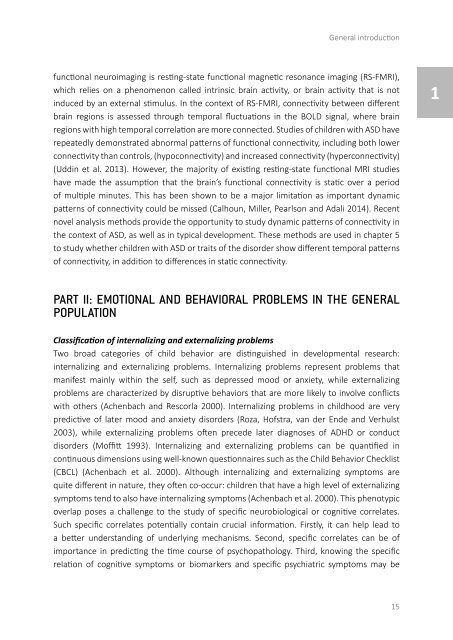On the Spectrum
2lm5UyR
2lm5UyR
Create successful ePaper yourself
Turn your PDF publications into a flip-book with our unique Google optimized e-Paper software.
General introduction<br />
functional neuroimaging is resting-state functional magnetic resonance imaging (RS-FMRI),<br />
which relies on a phenomenon called intrinsic brain activity, or brain activity that is not<br />
induced by an external stimulus. In <strong>the</strong> context of RS-FMRI, connectivity between different<br />
brain regions is assessed through temporal fluctuations in <strong>the</strong> BOLD signal, where brain<br />
regions with high temporal correlation are more connected. Studies of children with ASD have<br />
repeatedly demonstrated abnormal patterns of functional connectivity, including both lower<br />
connectivity than controls, (hypoconnectivity) and increased connectivity (hyperconnectivity)<br />
(Uddin et al. 2013). However, <strong>the</strong> majority of existing resting-state functional MRI studies<br />
have made <strong>the</strong> assumption that <strong>the</strong> brain’s functional connectivity is static over a period<br />
of multiple minutes. This has been shown to be a major limitation as important dynamic<br />
patterns of connectivity could be missed (Calhoun, Miller, Pearlson and Adali 2014). Recent<br />
novel analysis methods provide <strong>the</strong> opportunity to study dynamic patterns of connectivity in<br />
<strong>the</strong> context of ASD, as well as in typical development. These methods are used in chapter 5<br />
to study whe<strong>the</strong>r children with ASD or traits of <strong>the</strong> disorder show different temporal patterns<br />
of connectivity, in addition to differences in static connectivity.<br />
1<br />
PART II: EMOTIONAL AND BEHAVIORAL PROBLEMS IN THE GENERAL<br />
POPULATION<br />
Classification of internalizing and externalizing problems<br />
Two broad categories of child behavior are distinguished in developmental research:<br />
internalizing and externalizing problems. Internalizing problems represent problems that<br />
manifest mainly within <strong>the</strong> self, such as depressed mood or anxiety, while externalizing<br />
problems are characterized by disruptive behaviors that are more likely to involve conflicts<br />
with o<strong>the</strong>rs (Achenbach and Rescorla 2000). Internalizing problems in childhood are very<br />
predictive of later mood and anxiety disorders (Roza, Hofstra, van der Ende and Verhulst<br />
2003), while externalizing problems often precede later diagnoses of ADHD or conduct<br />
disorders (Moffitt 1993). Internalizing and externalizing problems can be quantified in<br />
continuous dimensions using well-known questionnaires such as <strong>the</strong> Child Behavior Checklist<br />
(CBCL) (Achenbach et al. 2000). Although internalizing and externalizing symptoms are<br />
quite different in nature, <strong>the</strong>y often co-occur: children that have a high level of externalizing<br />
symptoms tend to also have internalizing symptoms (Achenbach et al. 2000). This phenotypic<br />
overlap poses a challenge to <strong>the</strong> study of specific neurobiological or cognitive correlates.<br />
Such specific correlates potentially contain crucial information. Firstly, it can help lead to<br />
a better understanding of underlying mechanisms. Second, specific correlates can be of<br />
importance in predicting <strong>the</strong> time course of psychopathology. Third, knowing <strong>the</strong> specific<br />
relation of cognitive symptoms or biomarkers and specific psychiatric symptoms may be<br />
15


